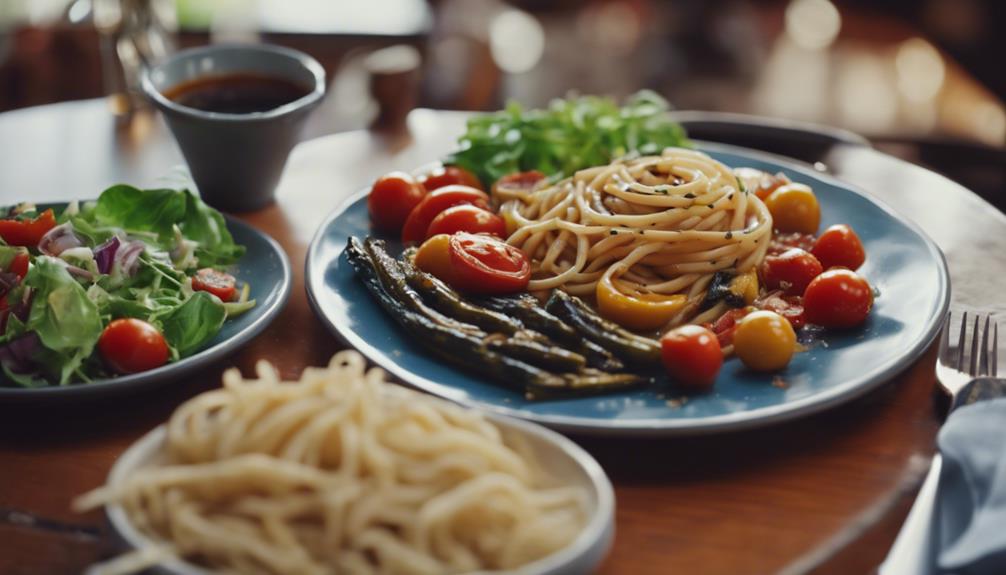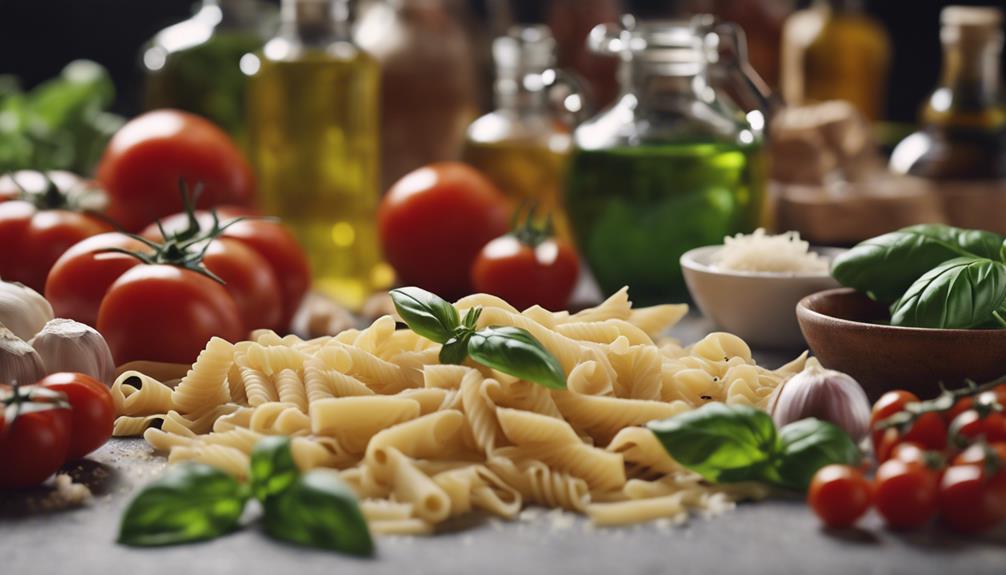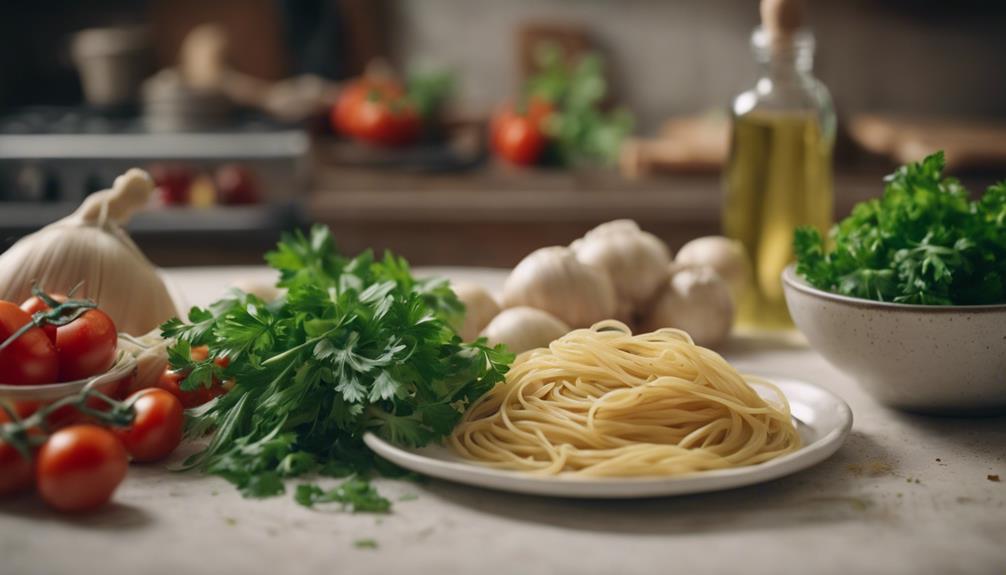Italian cuisine offers a healthy option! Nutrient-rich soups, lean proteins like fish and seafood, and fresh vegetables are prominent. Choose whole wheat pasta and lighter cooking techniques for a guilt-free dining experience. Ancient grains provide low GI benefits and fiber-rich pasta aids in digestion. Italian food combines flavor and health benefits with choices such as minestrone soup and roasted chicken. So, the next time you crave Italian food, remember it can be both delicious and nutritious! Give it a shot and uncover the secrets to a balanced and flavorful meal.
Key Takeaways
- Italian dishes can be healthy with lean proteins, fresh vegetables, whole grains, and olive oil.
- Nutrient-rich ingredients like beans, tomatoes, and spinach in Italian soups offer essential nutrients and fiber.
- Cooking methods like grilling, roasting, and using whole wheat pasta can reduce fat and calories.
- Ancient grains like farro and spelt in Italian cuisine provide rich nutrients and low glycemic index benefits.
- Fiber-packed pasta and polenta in Italian dishes support digestive health, weight management, and sustained energy levels.
Nutrient-Rich Italian Soups
When exploring healthy Italian dishes, you'll find that nutrient-rich Italian soups offer a satisfying and nourishing option. Italian soups like minestrone aren't only delicious but also low in calories and high in fiber, making them a fantastic choice for those looking to maintain a healthy diet.
Packed with ingredients such as spinach, beans, and tomatoes, these soups provide essential nutrients that contribute to overall well-being.
Lean Protein Options
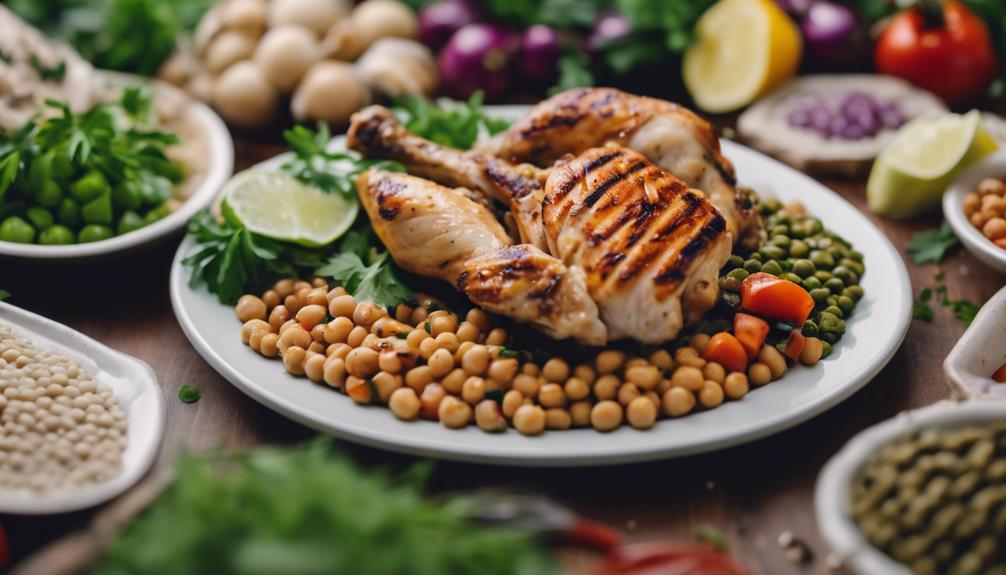
Looking for some lean protein options in Italian dishes? You're in luck! Italian cuisine offers a variety of protein sources such as white meat, fish, and seafood that aren't only delicious but also packed with essential nutrients.
From omega-3 fatty acids in fish to muscle-repairing proteins in chicken, these lean options can help you maintain a balanced and healthy diet.
Protein Sources
Lean protein options found in Italian dishes include white meat, fish, and seafood, providing essential nutrients for a balanced diet. Fish, a staple in Italian cuisine, not only offers lean protein but also supplies omega-3 fatty acids important for heart health. Additionally, protein-rich meals like chicken cacciatora aid in muscle repair and energy balance. Cheese, another common ingredient in Italian dishes, provides moderate amounts of calcium, protein, and vitamin B-12, contributing to overall health.
Check out the table below for a quick overview of these essential protein sources in Italian cuisine:
| Protein Sources | Benefits | Key Nutrients |
|---|---|---|
| White Meat | Lean protein source | Protein |
| Fish | Omega-3 fatty acids | Protein, nutrients |
| Seafood | Essential nutrients | Protein, minerals |
Nutritional Value
Italian dishes provide an array of lean protein options, offering essential nutrients to support overall well-being and muscle repair. In the Mediterranean diet, which is a cornerstone of Italian cuisine, lean proteins like white meat, fish, and seafood play a significant role.
Fish, a common ingredient in Italian recipes, isn't only low in fat but also rich in omega-3 fatty acids and essential nutrients. These lean protein sources aid in muscle repair, help maintain energy balance, and contribute to your overall well-being.
Including fish in your diet at least twice a week can provide you with the essential proteins and nutrients your body needs to thrive. White meat and seafood are excellent choices to incorporate into your meals for a healthy and balanced diet.
Cooking Methods
When preparing Italian dishes with lean protein options like white meat, fish, and seafood, consider utilizing healthier cooking methods to enhance their nutritional value. Opting for grilling or baking these lean protein choices can help reduce saturated fat content, making your meals not only delicious but also heart-healthy.
Fish, a common protein in Italian cuisine, is low in fat and packed with omega-3 fatty acids, benefiting your heart health. By choosing lean proteins and preparing them using smart cooking techniques, you can create nutritious Italian meals that support your overall well-being.
Including lean protein sources in your Italian dishes not only adds essential nutrients but also promotes muscle repair and energy balance. So next time you're whipping up a classic Italian recipe, think about how you can incorporate these lean protein options and cook them in ways that maximize their health benefits. Your taste buds and your body will thank you for the extra effort!
Lighter Versions of Classics

Opt for healthier cooking methods like grilling or roasting when preparing lighter versions of classic Italian dishes. By making simple swaps and adjustments, you can enjoy your favorite Italian flavors without compromising your healthy diet. Lighter Italian versions focus on reducing fat and calories while still retaining the traditional taste that you love. Ingredients like whole wheat pasta, lean proteins, and fresh vegetables are commonly used in these recipes. Additionally, substituting high-fat ingredients with healthier alternatives such as low-fat cheese or olive oil is a common practice in creating lighter Italian dishes. This balanced approach guarantees that you can savor the essence of Italian cuisine while prioritizing your health and nutrition.
| Ingredient | Healthier Alternative | Benefits |
|---|---|---|
| White Pasta | Whole Wheat Pasta | Higher Fiber Content |
| Ground Beef | Lean Turkey | Lower in Saturated Fat |
| Heavy Cream | Greek Yogurt | Reduced Calories |
| Regular Cheese | Low-Fat Cheese | Less Saturated Fat |
Fresh Vegetable Emphasis

Emphasizing the vibrant flavors and nutrient-rich benefits of fresh vegetables is key in elevating the health factor of your Italian dishes. When you incorporate a variety of fresh vegetables into your meals, you're not just adding color and texture, but also essential nutrients that are important for your overall well-being.
Here are some reasons why the fresh vegetable emphasis in Italian cuisine makes for a delicious and nutritious dining experience:
- Fresh vegetables are packed with essential nutrients that your body needs to function properly.
- They're naturally low in fat and calories, making them a healthy choice for those looking to maintain or lose weight.
- Italian dishes like minestrone soup and pasta primavera showcase the abundance of vegetables, providing necessary fiber for digestion.
- The flavors of fresh vegetables shine through in Italian cooking, enhancing the overall taste of the dish.
- By focusing on fresh, natural ingredients, Italian cuisine promotes a healthier lifestyle and contributes to the well-being of those who enjoy it.
Balanced Ingredients Selection
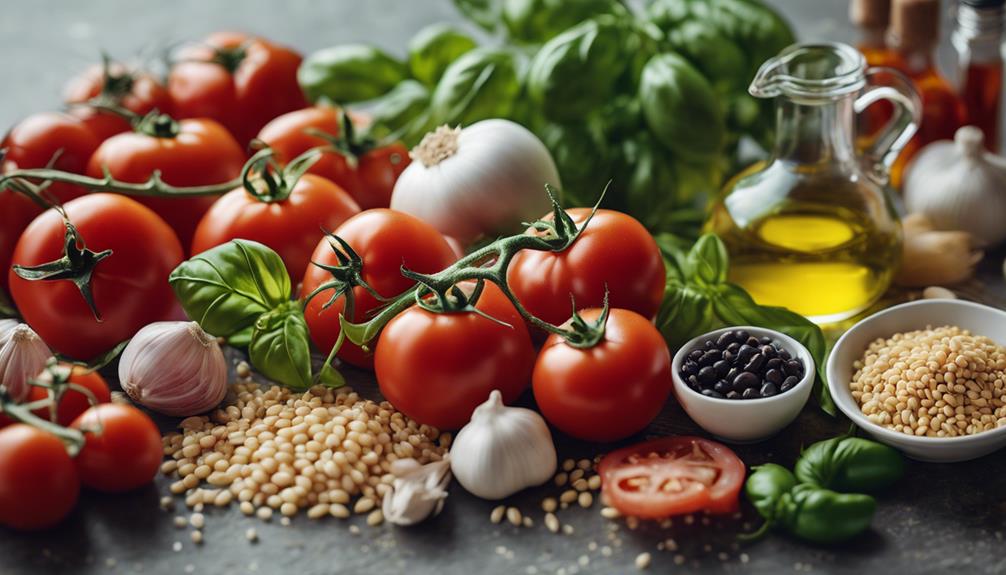
To ensure the healthfulness of your Italian dishes, focus on selecting a balanced array of ingredients that contribute to a nutritious meal. When crafting your meals, consider incorporating fresh vegetables, lean proteins, and whole grains to align with the traditional Italian diet and enhance the nutritional value of your dishes. Opt for olive oil as a crucial alternative to heavy creams or butter to add flavor without sacrificing health benefits. Including seafood like fish and shellfish can provide essential nutrients and healthy fats, further boosting the nutritional profile of your Italian creations. Remember, moderation and portion control play essential roles in enjoying Italian cuisine while maintaining a balanced and healthy diet. Check out the table below for a quick reference on balanced ingredients selection in Italian cooking:
| Ingredient | Contribution |
|---|---|
| Fresh Vegetables | Essential vitamins and minerals |
| Lean Proteins | Muscle building and repair |
| Olive Oil | Healthy fats and antioxidants |
Wholesome Italian Grains
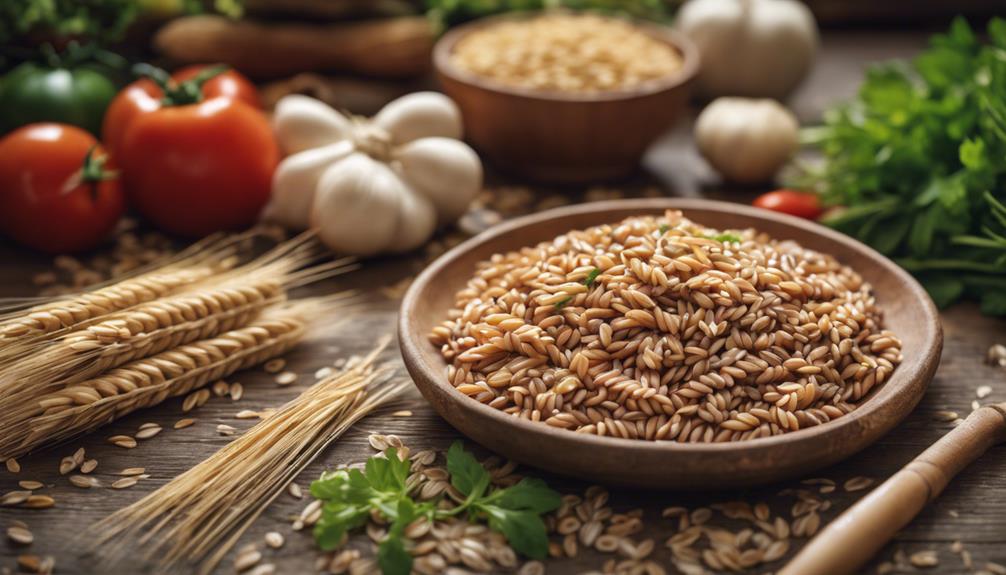
Let's chat about wholesome Italian grains. Nutrient-rich ancient grains like farro and fiber-packed whole wheat pasta are staples in Italian cuisine, offering a myriad of health benefits.
Plus, who can resist the comforting and nutritious goodness of polenta?
Nutrient-Rich Ancient Grains
Ancient grains like farro, spelt, and barley are essential components of Italian cuisine, offering a nutrient-rich and wholesome addition to your diet. These grains have been cherished for centuries, not just for their delicious taste but also for their incredible health benefits. Here's why you should consider incorporating these ancient grains into your meals:
- Rich in Protein, Vitamins, and Minerals: Farro, spelt, and barley are packed with essential nutrients that are crucial for your overall well-being.
- Low Glycemic Index: Compared to refined grains, these ancient grains have a lower glycemic index, which can help in managing blood sugar levels and weight.
- Versatile: From soups to salads, risottos, and side dishes, these grains offer a wide range of culinary possibilities.
- Digestive Benefits: Including ancient grains in your diet can improve digestion and boost your energy levels.
- Supports Overall Well-Being: The nutrients in these grains can help support your overall health, making them a valuable addition to your meals.
Fiber-Packed Pasta Choices
Including fiber-packed pasta choices in your Italian dishes can enhance the nutritional value of your meals while promoting digestive health and sustained energy levels.
Opting for whole wheat pasta options in your Italian cuisine is a vital choice. These fiber-rich pasta choices, such as whole grain spaghetti, not only aid digestion but also help in managing weight. The inclusion of whole grains in your Italian recipes can regulate blood sugar levels, providing you with a steady source of energy throughout the day.
Additionally, whole wheat pasta varieties offer essential nutrients like B vitamins, iron, and magnesium important for your overall well-being. By incorporating fiber-packed pasta choices in your Italian dishes, you aren't only satisfying your taste buds but also supporting a healthy gut microbiome, which is essential for improving your digestive health.
Benefits of Polenta
Incorporating polenta into your Italian dishes introduces a range of health benefits and culinary versatility. Polenta, a traditional Italian dish made from cornmeal, is a powerhouse of complex carbohydrates, offering sustained energy throughout your day.
Rich in fiber, polenta supports healthy digestion and helps you feel full longer, aiding in weight management. Since polenta is gluten-free, it's a fantastic option for those with gluten sensitivities or celiac disease, allowing them to enjoy a delicious dish without worry.
This versatile grain can be served creamy for a comforting meal or grilled for a crispy texture, providing a delightful culinary experience. Additionally, being low in fat and cholesterol-free, polenta is a heart-healthy choice that complements a well-rounded diet.
- Polenta is a traditional Italian dish rich in complex carbohydrates.
- It's a good source of fiber, aiding digestion and promoting fullness.
- Being gluten-free, polenta is suitable for individuals with gluten sensitivities.
- Polenta offers culinary versatility, being served creamy or grilled.
- This dish is low in fat and cholesterol-free, contributing to heart health.
Satisfying and Healthy Choices
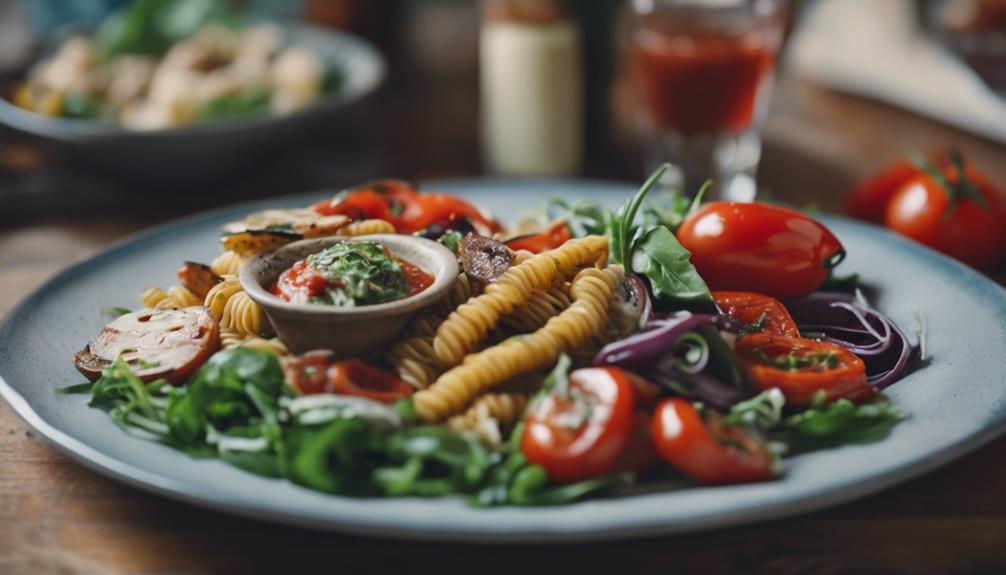
For satisfying and healthy choices when dining on Italian dishes, consider the nutrient-rich options available like Minestrone Soup, Steamed Clams, Roasted Chicken, Eggplant Parmigiana, and Whole Wheat Spaghetti Aglio Oglio.
Minestrone Soup is a fantastic choice for those seeking healthy options due to its low calorie count and vegan-friendly ingredients like spinach, beans, and carrots, making it a nutrient-rich and satisfying appetizer.
Steamed Clams offer a protein-packed seafood delight that pairs beautifully with vegetables and pasta for a balanced meal.
If you're looking for a savory and healthier main course, Roasted Chicken is a great pick as it's lower in fat and still scrumptious, ensuring a balanced diet.
Eggplant Parmigiana is a creative way to boost your veggie intake, providing a flavorful and nutrient-rich dish.
Lastly, Whole Wheat Spaghetti Aglio Oglio, prepared with olive oil and garlic, offers a lighter pasta alternative rich in protein and fiber, perfect for portion control and weight maintenance.
Enjoy these Italian delights guilt-free!
Frequently Asked Questions
How Healthy Is Italian Food?
When exploring how healthy Italian food is, you'll find a range of nutritious options. From fresh ingredients to heart-healthy olive oil, traditional Italian dishes offer a balanced diet. Enjoy dishes like minestrone soup and grilled fish for a wholesome meal.
Which Italian Food Is Healthiest?
When you're looking for the healthiest Italian food options, consider dishes like minestrone soup, steamed clams, roasted chicken, eggplant Parmigiana, and whole wheat spaghetti Aglio Oglio. These choices offer nutrition without sacrificing flavor.
Is Italian Food Better Than American Food?
Italian food is often a healthier choice compared to American cuisine. With a focus on fresh ingredients, vegetables, and healthy fats, Italian dishes offer a balanced approach to dining that can benefit your overall health.
Why Is Italy the Healthiest?
Italy is the healthiest due to factors like the Mediterranean diet, active lifestyle, and quality healthcare. Fresh ingredients, lean proteins, and family meals contribute to well-being. Embrace this balance for a healthier you.
How Can Italian Cuisine Be Both Delicious and Healthy?
Italian cuisine can transform your cooking forever with its emphasis on fresh ingredients and simple yet flavorful dishes. By using olive oil, herbs, and fresh vegetables, Italian recipes can be both delicious and healthy. With the right techniques and ingredients, anyone can enjoy the best of Italian cuisine while maintaining a healthy lifestyle.
Conclusion
So, the next time you're craving Italian food, remember that there are plenty of healthy options to choose from.
Whether it's nutrient-rich soups, lean protein dishes, or fresh vegetable-based meals, Italian cuisine offers a variety of delicious and satisfying choices that won't leave you feeling guilty.
With a focus on balanced ingredients and wholesome grains, you can indulge in your favorite dishes without sacrificing your health.
Mangia, enjoy, and feel good about your meal choices! Buon appetito!
